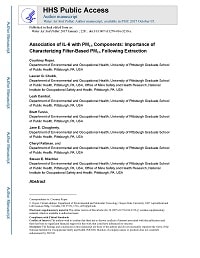Mining Publication: Association of IL-6 with PM2.5 Components: Importance of Characterizing Filter-based PM2.5 Following Extraction
Original creation date: January 2017
Authors: C Roper, LG Chubb, L Cambal, B Tunno, J Clougherty, C Fattman, SE Mischler
Filter-based toxicology studies are conducted to establish the biological plausibility of the well-established health impacts associated with fine particulate matter (PM2.5) exposure. Ambient PM2.5 collected on filters is extracted into solution for toxicology applications, but frequently, characterization is nonexistent or only performed on filter-based PM2.5, without consideration of compositional differences that occur during the extraction processes. To date, the impact of making associations to measured components in ambient instead of extracted PM2.5 has not been investigated. Filter-based PM2.5 was collected at locations (n = 5) and detailed characterization of both ambient and extracted PM2.5 was performed. Alveolar macrophages (AMJ2-C11) were exposed (3, 24, and 48 h) to PM2.5 and the pro-inflammatory cytokine interleukin (IL)-6 was measured. IL-6 release differed significantly between PM2.5 collected from different locations; surprisingly, IL-6 release was highest following treatment with PM2.5 from the lowest ambient concentration location. IL-6 was negatively correlated with the sum of ambient metals analyzed, as well as with concentrations of specific constituents which have been previously associated with respiratory health effects. However, positive correlations of IL-6 with extracted concentrations indicated that the negative associations between IL-6 and ambient concentrations do not accurately represent the relationship between inflammation and PM2.5 exposure. Additionally, seven organic compounds had significant associations with IL-6 release when considering ambient concentrations, but they were not detected in the extracted solution. Basing inflammatory associations on ambient concentrations that are not necessarily representative of in vitro exposures creates misleading results; this study highlights the importance of characterizing extraction solutions to conduct accurate health impact research.

- Diesel Exhaust Aerosol, Review of Measurement Technology
- Differential Pressure Response of 25-mm-Diameter Glass Fiber Filters Challenged with Coal and Limestone Dust Mixtures
- Instrumentation for Diesel Particulate Matter Emissions Research
- Morphological and Elemental Classification of Freshly Emitted Soot Particles and Atmospheric Ultrafine Particles using the TEM/EDS
- NIOSH Hazard ID 1 - Exposure to Silica Dust on Continuous Mining Operations Using Flooded-Bed Scrubbers
- Real-Time DPM Ambient Monitoring in Underground Mines
- Ringelmann Smoke Chart
- Role of Lubrication Oil in Particulate Emissions from a Hydrogen-Powered Internal Combustion Engine
- Sampling Results of the Improved SKC� Diesel Particulate Matter Cassette
- Thermally Induced Filter Bias in TEOM� Mass Measurement